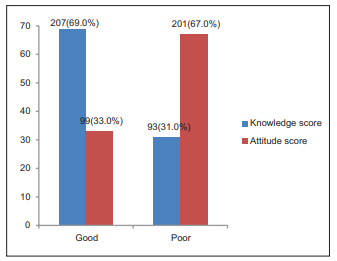Knowledge, pattern and determinants of the use of skin‑lightening creams among University Undergraduates in Southwestern Nigeria
Main Article Content
Abstract
Background: Fair skin has been associated with beauty and sexual attraction. Aggressive marketing of skin-lightening products to unsuspecting members of the general population continues despite their numerous side effects.
Aim: This study assessed the knowledge and pattern of the use of skin-lightening creams (SLCs) among undergraduates in Osun State, Southwestern Nigeria.
Methods: This is a descriptive, cross-sectional study among University undergraduates. Three hundred undergraduates were selected using multistage sampling method. The research instrument used was a semi-structured, self-administered, pretested questionnaire. Data were analysed using the SPSS version 23.0 software.
Results: The mean age of the students was 21.0 (±3.4) years. Most (283, i.e., 94.3%) of the students were aware of SLCs, with the Internet being the most common source of information. About 69.0% had good knowledge, while 67.0% had a poor attitude towards the use of SLC. Eighty-one (27.0%) respondents knew that SLC had side effects, 114 (38.0%) had ever used SLC, 69 (60.5%) still use SLC now, while 45 (39.5%) have stopped. Among those who had ever used, 108 (94.7%) said that they knew the chemical ingredient in SLC, 34 (29.8%) usually checked the label before use, 108 (94.7%) usually obtained SLC products from the supermarkets/shops. Predictors of the use of SLC in this study were female and age older than 19 years.
Conclusion: Good knowledge but poor attitude characterised the significant proportion of SLC users under the study, and this underscored the need for improved public awareness in this regard and targeting this young, vulnerable population.
Downloads
Article Details
The journal grants the right to make small numbers of printed copies for their personal non-commercial use under Creative Commons Attribution-Noncommercial-Share Alike 3.0 Unported License.
References
1. Christopher AD. Skin bleaching and the prestige complexion of sexual attraction. Sex Cult 2011;15:375‑90.
2. Olumide YM. Use of skin lightening creams. BMJ 2010;341:c6102.
3. Levang J, Eygonnet F, Humbert P. Pandalao and skin whitening in Mayotte. Ann Dermatol Venereol 2009;136:681‑6.
4. Mahé A. The practice of skin‑bleaching for a cosmetic purpose in immigrant communities. J Travel Med 2014;21:282‑7.
5. Kouotou EA, Bissek AC, Nouind CC, Defo D, Sieleunou I, Ndam EC. The practice of skin bleaching and associated skin diseases among female traders in Yaoundé, Cameroon (sub‑Saharan African). Ann Dermatol Venereol 2015;142:443‑5.
6. Araoye MO. Sampling methods. In: Research Methodology with Statistics for Health and Social Sciences. Ilorin, Nigeria: Nathadex Publishers; 2004. p. 117‑20.
7. Askari SH, Sajid A, Faran Z, Sarwar SZ. Skin‑Lightening Practice among Women Living in Lahore: Prevalence, Determinants, and User’s
Awareness. Skin‑Lightening Practice among Women Living in Lahore; 2017. Available from https://cgr.umt.edu.pk/icobm2013/papers/Papers/. [Last accessed on 2019 Sep 23].
8. Adebajo SB. An epidemiological survey of the use of cosmetic skin lightening cosmetics among traders in Lagos, Nigeria. West Afr J Med
2002;21:51‑5.
9. Kouotou EA, Jobert RN. Skin whitening among Cameroonian female university students: Knowledge attitudes practices and motivations.
BMC Womens Health 2017;17:33.
10. Peltzer K, Pengpid S. Knowledge about, attitude toward, and practice of skin lightening products use and its social correlates among university students in five Association of Southeast Asian Nations (ASEAN) countries. Int J Dermatol 2017;56:277‑83.
11. Dlova N, Hamed SH, Tsoka‑Gwegweni J, Grobler A, Hift R. Women’s perceptions of the benefits and risks of skin‑lightening creams in two South African communities. J Cosmet Dermatol 2014;13:236‑41.
12. Rusmadi SZ, Syed Ismail SN, Praveena SM. Preliminary study on the skin lightening practice and health symptoms among female students
in Malaysia. J Environ Public Health 2015;2015:591790.
13. Alghamdi KM. The use of topical bleaching agents among women: A cross‑sectional study of knowledge, attitude and practices. J. Eur. Acad. Dermatol Venereol 2010;24:1214‑9.
14. OlumideYM, AkinkugbeAO, Altraide D, Mohammed T, Ahamefule N, Ayanlowo S, et al. Complications of chronic use of skin lightening
cosmetics. Int J Dermatol 2008;47:344‑53.


